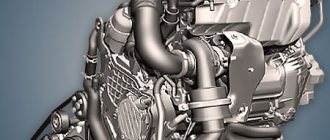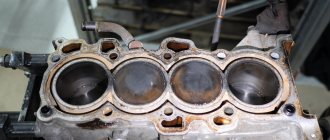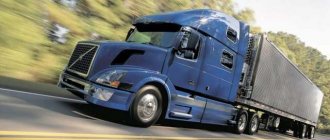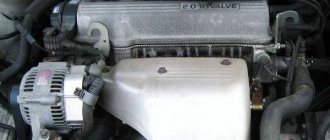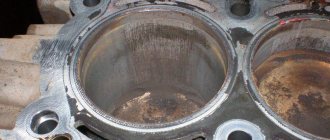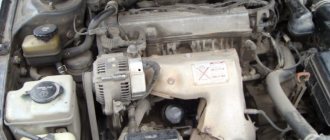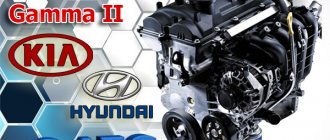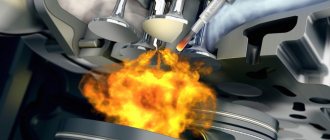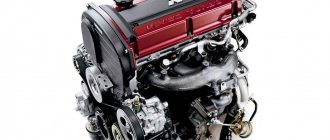CRDi engine analogs
First of all, it’s worth talking about analogues of the CRDi motor, which are similar in design:
- Fiat produces a similar engine under the abbreviation CDTi;
- Ford produces a similar engine called TDCi;
- General Motors produces such engines under the abbreviation CDTi or VCDi;
- Volkswagen calls such engines TDI.
Other companies also have analogues of the CRDi motor from Korean manufacturers, but they are less common than those mentioned above.
All of the engines listed are, in general, close to each other in terms of the general concept. They have some minor differences in design, but they are all diesel and have a direct fuel injection system.
Disadvantages and weaknesses of D4EA
D4EA engine
The D4EA engine, of course, has its weak points.
For example, the most expensive problem is the breakdown of fuel equipment (as in any diesel engine).
timing belt life of the D4EA engine is not very long, but its replacement is necessary, because if it breaks, it will bend the valves . It is better to change the gas distribution drive every 60 - 70 thousand .
Over time, the washers under the injectors burn out, and because of this, strong carbon deposits form.
USR valve D4EA
The EGR valve is stuck in the open position.
With significant mileage, cracking of the Cylinder Head occurs.
A clogged receiver entails oil starvation, the consequences of which are rotation of the liners .
As you can see, D4EA has .
Possible causes of oil burn
D4EA engine
In the basic version, the 112-horsepower D4EA engine does not have an oil trap in the crankcase gas ventilation system. In this version, only plate . Some drivers installed oil traps of their own design, but its simplicity leads to the fact that the oil enters the combustion chambers, where it burns along with the fuel. This is one of the reasons for oil burning. The valve cover should be cleaned periodically to eliminate increased oil consumption.
Steam from the oil filler neck can be caused by a clogged breather in the crankcase gas ventilation system. This cannot be started, oil burn can progress quickly, which is why the lubrication level can drop below the permissible level. The lubrication of the crankshaft journals will be disrupted, with consequences in the form of rotation of the bearings , and sometimes it can cause destruction of the connecting rod journals .
There are no complaints about the VGK valve of the 2.0 CRDI engine. Here it is used in a membrane design, and such valves have a very long service life.
Fuel supply system
The Bosch fuel system with which the D4EA is equipped is capricious regarding fuel quality. A worn injector begins to drain a lot of fuel into the return line. Because of this, the D4EA begins to operate unstably and has problems starting. In this case, unstable operation is caused even by wear of one of the 4 nozzles. If the injector starts to inject a lot of fuel, this may even require a major overhaul.
Fuel burner
D4EA engine injectors require careful and regular testing on a bench.
The fuel pressure regulator also causes many problems. If both the regulator and the pressure sensor malfunction, the engine begins to stall during acceleration and has difficulty starting.
The copper fireproof washer installed under the injector can also burn out, and both the injector seat and the cylinder head cavity become coked. And this leads to the formation of excess pressure not only under the valve cover, but also in the crankcase gas ventilation system.
Operating principle of the CRDi engine
A feature of CRDi diesel engines (and analogues) is that fuel is supplied to the injection nozzles from a common tank where the fuel is under high pressure. Thus, this design, unlike conventional diesel engines with a fuel pump and cam drive, allows fuel to be supplied under high pressure.
In general, the operation process of the CRDi engine is as follows:
- When you turn the ignition key, diesel fuel is pumped into the Common-rail fuel rail using a special pump (this rail is the reservoir indicated above);
- In the rack, the fuel is constantly under pressure for injection due to the pumping;
- After this, fuel is directed from this rail under pressure to the injection nozzles through the fuel lines.
The principle of operation of the engine and its main analogues
The main feature of CRDI diesel engines is that they supply fuel to the injection nozzles from a common reservoir. Thus, it turns out that such a design, unlike conventional diesel engines, where there is a fuel pump and a cam drive, allows fuel to be supplied under high pressure. The operating principle of such a unit involves pumping diesel fuel immediately after turning the ignition key. Due to this, the fuel in the rack is constantly under pressure for injection. As a result, fuel comes out of the rack and is directed under pressure directly to the injection nozzles through the corresponding fuel lines. In terms of design, the following are considered analogues of such motors:
- Engines produced under the abbreviation CDTi by Fiat;
- Ford TDCi engines;
- Motors of the General concern under the abbreviation CDTi or VCDi;
- TDI engines belonging to the manufacturer Volkswagen.
According to the general concept, all of the listed engines are very close to each other. They have some minor differences in design, but they are all diesel and have a direct fuel injection system.
Advantages of the CRDi engine and its analogues
A diesel engine of this design, which has a direct injection system, has a number of obvious advantages over conventional engines:
Due to the high pressure that is constantly maintained in the system, it becomes possible to more efficiently direct diesel fuel to work. Fuel combustion occurs as much as possible, which is why less fuel is spent on engine operation;
Increased efficiency.- Environmentally friendly. Reducing the amount of fuel consumed and maximizing the complete combustion of the working mixture leads to an overall reduction in exhaust toxicity;
- Constant fuel pressure. In direct injection systems, fuel pressure does not depend on crankshaft speed, fuel volume and other indicators due to constant pressure build-up in the fuel rail;
- Fuel supply via EDC electronic unit. The increase in play in the injection nozzle occurs due to the command from the electronic unit transmitted to the controlled solenoid. That is, this process does not require any influence from the fuel;
- Electronic control . Parameters such as the injection advance angle, the amount of fuel injected and the injection pressure are set programmatically in the electronic control unit. This allows you to select optimal values for various engine operating modes. At the software level, among other things, you can set the injection pressure, depending on the parameters of the speed limit, load, and so on;
- Low noise level. In the systems under consideration, phased injection is implemented (in modern engines there are up to 9 phases). In addition to the advantages for speed characteristics, phased injection allows you to reduce the noise level from engine operation;
- High fuel pressure. Conventional diesel engines do not allow fuel pressure to exceed 300 kg/cm2, while in direct injection systems this value is above 2000 kg/cm2.
Advantages and disadvantages of CRDI motors
To begin with, it is worth noting the advantages of such power units. Such engines, due to the high pressure that is constantly maintained in the system, more efficiently direct diesel fuel into operation. Due to this, fuel combustion occurs as much as possible and, accordingly, less fuel is spent on engine operation. In addition, due to the reduction in the amount of fuel consumed and its combustion as complete as possible, the toxicity of exhaust gases on such engines is minimized. Fuel injection systems maintain constant fuel pressure. In such units, all parameters are controlled by an electronic control unit. Accordingly, all parameters are optimal for various engine operating modes. In addition, in the systems under consideration, phased injection is implemented, which, in addition to advantages in terms of speed characteristics, can significantly reduce the noise level during engine operation. Despite the fact that such a system is in many ways superior to standard diesel engines, it also has certain deliveries:
- Increased sensitivity to fuel quality;
- Higher cost of the unit;
- Expensive repairs due to the more complex design of the power plant.
More information about CRDI engines will be discussed in this video:
Published: July 13, 2021
Disadvantages of the CRDi engine and its analogues
The CRDi system technology itself is significantly superior to a standard diesel engine. But it is much more complex, which results in a number of disadvantages:
Due to the complexity of the system design, there is a high risk of damage to it when various debris that may be present in the fuel gets into the fuel pump, injector and other elements. Therefore, for CRDi engines it is necessary to use high-quality diesel without foreign impurities;
Sensitivity to fuel quality.- High price. As can be understood from the description of the CRDi engine, its design is much more complex than that of a conventional diesel engine. For correct operation of Common Rail, several sensors are required, and it is also necessary to correctly program the operation of the electronic control unit. All this significantly increases the cost of a CRDi engine compared to conventional diesel engines;
- Complexity and cost of repairs. CRDi motors are much more complex, and not all service centers undertake their diagnostics and repairs. For their high-quality service, you need to have special equipment and employees with appropriate qualifications who understand the principle of operation of Common Rail. At the same time, the system itself is not particularly suitable for repair, and many of its elements can only be changed modularly, which increases the cost of maintenance.
There is a common misconception about the low reliability of the CRDi engine and its analogues. This is due to the fact that the engine has increased requirements for the quality of diesel fuel. Since not all gas stations in Russia can provide high-quality fuel, this leads to engine failure.
( 119 votes, average: 4.53 out of 5)
Engine cylinder honing
Grinding the cylinder head (cylinder head)
Related Posts
Bosch fuel system
The fuel system is capricious and very sensitive to fuel quality. Worn injectors begin to drain a lot of fuel into the return line, which is why the 2.0 CRDI engine has difficulty starting and stalls. For unstable engine operation, one injector pouring into the return line is enough.
But if the injector starts to spray fuel incorrectly and inject fuel too early, then you may end up having to undergo a major engine overhaul. Due to improper combustion of the fuel mixture, the piston in the cylinder with incorrect fuel atomization burns and is destroyed. In general, injectors on a 2.0 CRDI engine require close inspection and preventive testing on a bench.
In addition, the fireproof copper washers under the injectors naturally burn out, which causes coking of both the injector sockets and the cylinder head cavity, resulting in excess pressure under the valve cover and in the crankcase ventilation system.
You can buy diesel fuel injectors for the Hyundai or Kia 2.0 CRDI (D4EA) engine from.
Separate troubles are caused by failed fuel pressure regulators and a fuel pressure sensor installed on the ramp. If the regulator malfunctions, the 2.0 CRDI engine stalls during acceleration and starts hesitantly. If the pressure sensor is faulty, it does not develop speed.
You can buy a fuel pump (fuel pump) for a Hyundai or Kia 2.0 CRDI (D4EA) engine from.
How does a CRDI engine work?
Common Rail in the name of such engines tells us that there is one common fuel line. Indeed, CRDI engines use such a line, sometimes called a rack, in which the fuel is under constant, high pressure. This pressure is provided by the high pressure fuel pump, familiar to motorists from previous diesel systems. But unlike the classic injection pump system, the injectors do not open under the influence of excess pressure, but with the help of special solenoids, which are controlled by the EDC unit. In Common Rail Direct Injection, the pressure in the system does not depend on either the crankshaft speed or the amount of fuel itself. Here the driver can only influence the amount of fuel that is injected, but the advance angle and the pressure with which diesel fuel is injected are all regulated by the engine’s electronic control unit. This solution makes it possible to separate the injection of working pressure and the injection itself. And this, in turn, makes it possible to use more than one injection phase in one cycle. At first, two-phase CRDIs were produced, but now some engines use up to nine injection phases per stroke.

